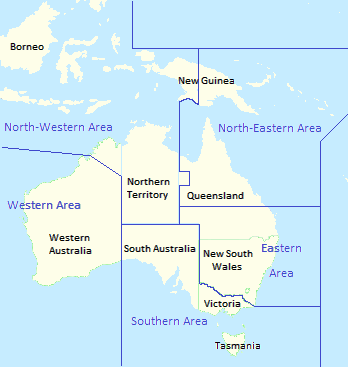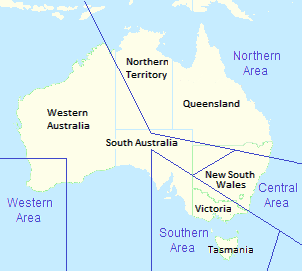Southern Area Command (RAAF)
| Southern Area Command | |
|---|---|
|
Provisional RAAF area command boundaries, February 1940 | |
| Active | 1940–53 |
| Allegiance | Australia |
| Branch | Royal Australian Air Force |
| Role |
Air defence Aerial reconnaissance Protection of adjacent sea lanes |
| Garrison/HQ | Melbourne |
| Engagements | World War II |
| Commanders | |
| Notable commanders |
Henry Wrigley (1940) Adrian Cole (1940–41) Frank Bladin (1941) Ian McLachlan (1944–45) Charles Eaton (1945) Allan Walters (1948–50) Alan Charlesworth (1951–53) |
Southern Area Command was one of several geographically based commands raised by the Royal Australian Air Force (RAAF) during World War II. It was formed in March 1940, and initially controlled units based in Victoria, Tasmania, South Australia and southern New South Wales. Headquartered at Melbourne, Southern Area Command was primarily responsible for air defence, aerial reconnaissance and protection of the sea lanes within its boundaries. From 1942 its operational responsibilities excluded New South Wales. The area continued to operate following the end of the war, before being re-formed in October 1953 as Training Command under the RAAF's new functional command-and-control system.
History
World War II
Prior to World War II, the Royal Australian Air Force was small enough for all its elements to be directly controlled by RAAF Headquarters in Melbourne. After war broke out in September 1939, the RAAF began to decentralise its command structure, commensurate with expected increases in manpower and units.[1][2] Its initial move in this direction was to create Nos. 1 and 2 Groups to control units in Victoria and New South Wales, respectively.[3] Then, between March 1940 and May 1941, the RAAF divided Australia and New Guinea into four geographically based command-and-control zones: Central Area, Southern Area, Western Area, and Northern Area.[4] The roles of these area commands were air defence, protection of adjacent sea lanes, and aerial reconnaissance. Each was led by an Air Officer Commanding (AOC) responsible for the administration and operations of all air bases and units within his boundary.[2][4]
No. 1 Group, which had been established on 20 November 1939, was re-formed as one of the first two area commands, Southern Area, on 7 March 1940. Headquartered in Melbourne, Southern Area Command was given control of all Air Force units in Victoria, Tasmania, South Australia and the southern Riverina district of New South Wales.[5] Its inaugural AOC was Air Commodore Henry Wrigley, who had also led No. 1 Group.[6] His senior administrative staff officer was Group Captain Joe Hewitt.[7] Wrigley handed over command to Air Commodore Adrian "King" Cole, formerly AOC Central Area, in November 1940.[6]
By August 1941, the RAAF's expanding instructional program necessitated the establishment of overarching training organisations on a semi-functional, semi-geographical basis. Accordingly, on 2 August 1941, No. 1 (Training) Group was formed in Melbourne to assume responsibility for training units within Southern Area's boundaries, while No. 2 (Training) Group was formed in Sydney to take over training units then under Central Area, which was disbanded; control of other Central Area units was "divided as convenient" between Southern and Northern Area Commands.[8][9] Air Commodore Frank Bladin held command of Southern Area from September to December 1941.[6]
As of 20 April 1942, operational authority over all RAAF combat infrastructure, including area commands, was invested in the newly established Allied Air Forces (AAF) Headquarters under South West Pacific Area Command (SWPA).[10][11] On 15 May, Southern Area, which by then was considered too large, yielded responsibility for operational and maintenance units within New South Wales to a new area command, Eastern Area. Control of maintenance units under Southern Area was transferred to the newly established No. 4 (Maintenance) Group in Melbourne on 14 September.[12] September also saw the formation of RAAF Command, led by Air Vice Marshal Bill Bostock, to oversee the majority of Australian flying units in the SWPA.[13][14] Bostock exercised control of air operations through the area commands, although RAAF Headquarters continued to hold overarching administrative authority over Australian units.[15]

By April 1943, Southern Area was operating two combat units: No. 67 Squadron, flying maritime reconnaissance and anti-submarine missions with Avro Ansons out of RAAF Station Laverton, Victoria; and No. 86 Squadron, flying P-40 Kittyhawk fighters from Gawler, South Australia.[16] Group Captain Ian McLachlan commanded the area from March 1944 until January 1945, when he handed over to Group Captain Charles Eaton.[6] The German submarine U-862 operated off southern Australia during the first months of 1945, and the few combat units in Southern Area were heavily engaged in anti-submarine patrols, attempting unsuccessfully to locate this and any other U-boats in the vicinity.[17] Eaton led the command through to the surrender of Japan in September, and into December 1945.[6][18]
Post-war reorganisation
Following the end of the Pacific War in August 1945, SWPA was dissolved and RAAF Headquarters again assumed full control of all its operational formations, including the area commands.[19] In September 1946, the Chief of the Air Staff, Air Vice Marshal George Jones, proposed reducing the five extant mainland area commands (North-Western, North-Eastern, Eastern, Southern, and Western Areas) to three: Northern Area, covering Queensland and the Northern Territory; Eastern Area, covering New South Wales; and Southern Area, covering Western Australia, South Australia, Victoria and Tasmania. The proposal was part of a much larger plan to restructure the post-war RAAF; the Federal government rejected the plan and the wartime area command boundaries essentially remained in place.[20][21] RAAF College (which became RAAF Academy in 1961) was established at RAAF Station Point Cook, Victoria, under Southern Area Command in August 1947.[22] The area's later AOCs included Air Commodores Allan Walters, during 1948–50, and Alan Charlesworth, the last officer to command the area, during 1951–53.[23][24]
The Federal government retired Jones in 1952 and replaced him with Air Marshal Donald Hardman, RAF, who proceeded to re-organise the RAAF command-and-control system along functional lines, establishing Home (operational), Training, and Maintenance Commands. The first was re-formed from the existing Eastern Area Command, which was considered a de facto operational organisation owing to the preponderance of combat forces within its sphere. The second was re-formed from Southern Area Command, as it was already the hub of training services, controlling those in New South Wales and Queensland as well as Victoria and South Australia. The third and final functional command was formed from the extant Maintenance Group headquarters in Melbourne. The transition to a functional system was completed in February 1954, when the three new commands assumed control of all operations, training and maintenance from Western, North-Western, and North-Eastern Area Commands.[25][26]
Aftermath
The functional commands established in 1953–54 were revised in 1959. Home Command was renamed Operational Command, and Training and Maintenance Commands merged to become Support Command.[27] Operational Command was renamed Air Command in 1987, and three years later Support Command split into Logistics Command and Training Command.[28] Training Command was re-formed as Air Force Training Group, a force element group under Air Command, in 2006.[29]
Order of battle
As at 30 April 1942, Southern Area's order of battle comprised:[30]
- RAAF Station Laverton
- General Reconnaissance School, Cressy
- No. 7 (General Reconnaissance) Squadron, Bairnsdale
- No. 7 Fighter Sector Headquarters, Melbourne
- RAAF Station Richmond
- RAAF Station Canberra
- RAAF Station Rathmines
- No. 2 Fighter Sector Headquarters, Newcastle
Notes
- ↑ Stephens, The Royal Australian Air Force, pp. 111–112
- 1 2 "Organising for war: The RAAF air campaigns in the Pacific". Pathfinder. No. 121. Air Power Development Centre. October 2009. Retrieved 10 July 2015.
- ↑ Gillison, Royal Australian Air Force, pp. 66–67
- 1 2 Gillison, Royal Australian Air Force, pp. 91–92
- ↑ Ashworth, How Not to Run an Air Force, pp. xix–xx, 27–29
- 1 2 3 4 5 Ashworth, How Not to Run an Air Force, pp. 302–304
- ↑ "Many Air Force promotions appointments". The Courier-Mail. Brisbane: National Library of Australia. 25 April 1940. p. 2. Retrieved 20 July 2015.
- ↑ Gillison, Royal Australian Air Force, p. 112
- ↑ Ashworth, How Not to Run an Air Force, pp. xx, 38
- ↑ Gillison, Royal Australian Air Force, p. 473
- ↑ Odgers, Air War Against Japan, pp. 15–16
- ↑ Ashworth, How Not to Run an Air Force, pp. xxi, 134–135
- ↑ Gillison, Royal Australian Air Force, pp. 585–588
- ↑ Odgers, Air War Against Japan, pp. 4–6
- ↑ Stephens, The Royal Australian Air Force, pp. 144–145
- ↑ Odgers, Air War Against Japan, p. 141
- ↑ Odgers, Air War Against Japan, pp. 351–354
- ↑ "Eaton, Charles". World War 2 Nominal Roll. Retrieved 20 July 2015.
- ↑ Ashworth, How Not to Run an Air Force, p. 262
- ↑ Helson, The Private Air Marshal, pp. 321–325
- ↑ Stephens, Going Solo, pp. 68, 462
- ↑ Frost, RAAF College & Academy, pp. 6, 45
- ↑ "Air Vice-Marshals (L–Z)". Air Marshals of the RAAF. Air Power Development Centre. Retrieved 20 July 2015.
- ↑ "Honorary Air Vice-Marshals". Air Marshals of the RAAF. Air Power Development Centre. Retrieved 20 July 2015.
- ↑ "Sir Donald Hardman's reorganisation of the RAAF". Pathfinder. No. 106. Air Power Development Centre. March 2009. Retrieved 10 July 2015.
- ↑ Stephens, Going Solo, pp. 73–76, 462–463
- ↑ Stephens, Going Solo, pp. 76–77
- ↑ Dennis et al, The Oxford Companion to Australian Military History, pp. 150–151
- ↑ "Air Force Training Group". Royal Australian Air Force. Retrieved 10 July 2015.
- ↑ Ashworth, How Not to Run an Air Force, pp. 299–300
References
- Ashworth, Norman (2000). How Not to Run an Air Force! Volume One – Narrative. Canberra: RAAF Air Power Studies Centre. ISBN 0-642-26550-X.
- Dennis, Peter; Grey, Jeffrey; Morris, Ewan; Prior, Robin (2008) [1995]. The Oxford Companion to Australian Military History. South Melbourne: Oxford University Press. ISBN 978-0-19-551784-2.
- Frost, R.E. (1991). RAAF College & Academy 1947–86 (PDF). Canberra: Royal Australian Air Force. ISBN 978-0-646-08518-0.
- Gillison, Douglas (1962). Australia in the War of 1939–1945: Series Three (Air) Volume I – Royal Australian Air Force 1939–1942. Canberra: Australian War Memorial. OCLC 2000369.
- Helson, Peter (2010). The Private Air Marshal. Canberra: Air Power Development Centre. ISBN 978-1-920800-50-5.
- Odgers, George (1968) [1957]. Australia in the War of 1939–1945: Series Three (Air) Volume II – Air War Against Japan 1943–1945. Canberra: Australian War Memorial. OCLC 246580191.
- Stephens, Alan (1995). Going Solo: The Royal Australian Air Force 1946–1971. Canberra: Australian Government Publishing Service. ISBN 0-644-42803-1.
- Stephens, Alan (2006) [2001]. The Royal Australian Air Force: A History. London: Oxford University Press. ISBN 0-19-555541-4.
